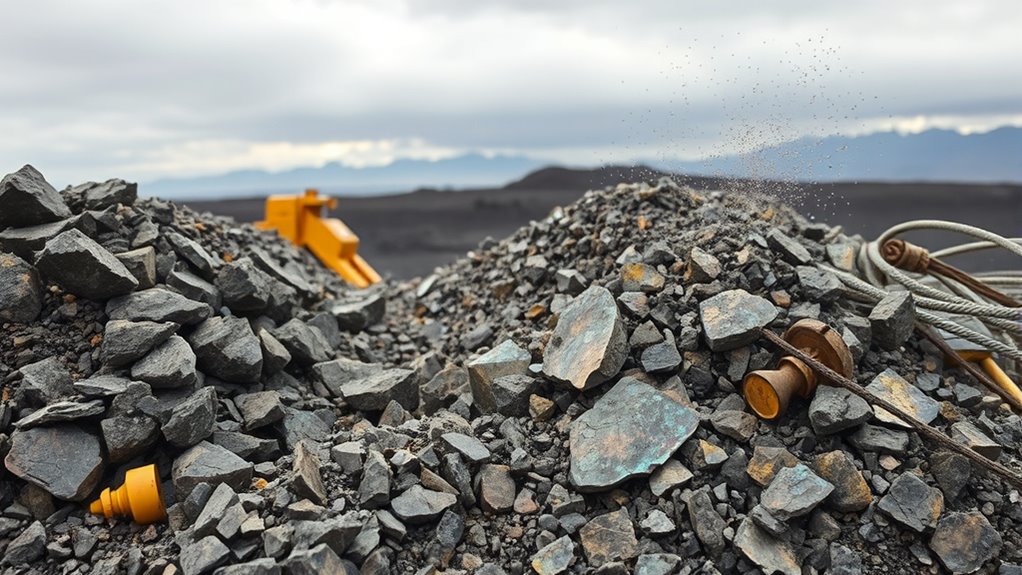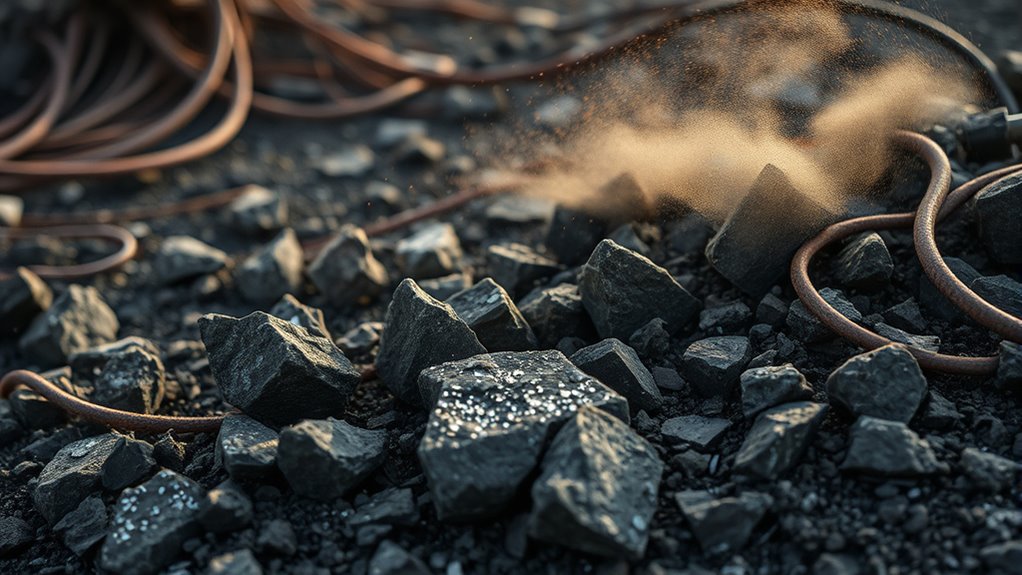You rely on rare earths every day to power AI hardware like magnets, batteries, and electronic components. Despite their name, these minerals are vital for advanced technology but are often overlooked in environmental discussions. Their extraction can harm ecosystems and deplete finite supplies, mostly controlled by a few countries, creating geopolitical risks. If you want to understand how this affects your tech and future innovations, there’s more to uncover about this hidden crisis.
Key Takeaways
- AI hardware relies on rare earths for essential components like magnets and batteries, enabling advanced technological capabilities.
- Mining rare earths is environmentally damaging, causing pollution, habitat destruction, and water contamination.
- Supply is highly concentrated, mainly controlled by China, creating geopolitical risks and potential shortages.
- Recycling and alternative materials are being developed to reduce dependency and mitigate environmental impact.
- Sustainable management and diversified sourcing are critical to address the environmental and supply chain challenges associated with rare earths.

Rare earth elements play a crucial role in powering AI hardware, even though their name might suggest rarity. These minerals are essential for manufacturing the magnets, batteries, and electronic components that make AI devices possible. But behind their technological importance lies a complex web of issues that can’t be ignored—particularly concerning their environmental impact and the fragile supply chain that delivers them to us. As you rely more on AI-powered devices, it’s important to understand how these materials are sourced and the consequences of their extraction.
Rare earths are vital for AI but pose environmental and supply chain challenges we must address.
The environmental impact of rare earth mining is significant. Extracting these minerals often involves energy-intensive processes that generate substantial amounts of waste and pollution. In many cases, mining operations release toxic chemicals into surrounding ecosystems, contaminating water supplies and harming local wildlife. The process can also lead to deforestation and soil erosion, disrupting habitats and community livelihoods. If you’re concerned about sustainable tech, you should recognize that the environmental toll of acquiring these elements is often overlooked in discussions about AI advancement. The push for more powerful AI hardware therefore risks perpetuating environmental degradation if responsible sourcing isn’t prioritized.
Furthermore, the supply chain for rare earth elements is highly concentrated, making it vulnerable to disruptions. A significant portion of the world’s supply comes from a handful of countries, particularly China, which controls most of the refining and processing. This reliance on a limited geographic region creates geopolitical risks—trade tensions, export restrictions, or political instability can all interrupt the flow of these critical materials. As a consumer or industry stakeholder, you might not see the immediate effects, but supply chain interruptions can lead to shortages, delays in AI hardware production, and increased costs. This concentration of supply raises questions about the resilience of the entire AI hardware ecosystem and highlights the need for diversification and recycling efforts.
In addition, ongoing research into alternative materials and recycling initiatives offers hope for reducing the environmental and geopolitical challenges associated with rare earths. Moving forward, your dependence on AI hardware is intertwined with these complex issues surrounding the supply of rare earths. While they are indispensable for the latest technology, their extraction and processing pose serious environmental challenges, and the supply chain’s fragility can threaten future innovation. There’s an urgent need for sustainable sourcing practices, recycling initiatives, and alternative materials that can reduce reliance on these finite resources. Recognizing these underlying issues empowers you to make more informed choices about the technology you use and support. The future of AI depends not just on breakthroughs in algorithms but also on how responsibly we manage the raw materials that fuel its hardware.
Frequently Asked Questions
How Does the Mining Process for Rare Earths Impact Local Communities?
When you consider rare earth mining, you should realize it often leads to community displacement and environmental degradation. Local communities face displacement as land is cleared for mining operations, disrupting lives and livelihoods. Additionally, mining processes release harmful chemicals, polluting the environment and damaging local ecosystems. These impacts can last for years, making it difficult for communities to recover and thrive after the mining activities cease.
Are There Alternative Materials to Rare Earths for AI Hardware?
Imagine finding new ways to build smarter tech without relying solely on rare earths. Researchers are making exciting research advancements to explore alternative materials, like lithium, graphene, and recycled metals, that could power AI hardware effectively. While these options are promising, they still need more development. You can stay hopeful, knowing that innovation is paving the way for more sustainable and resource-friendly AI solutions in the future.
What Policies Are in Place to Secure Rare Earth Supply Chains?
You should know that policies aim to strengthen supply chain resilience and manage trade restrictions around rare earths. Governments often promote strategic stockpiles, invest in domestic mining, and negotiate trade agreements to secure these critical minerals. These measures help reduce reliance on unstable foreign sources, ensuring a stable supply for AI hardware. Staying aware of such policies helps you understand how global efforts try to mitigate risks in rare earths supply chains.
How Does Recycling Rare Earths Contribute to Sustainability?
Did you know that recycling rare earths can recover up to 90% of valuable materials? When you support recycling efforts, you boost recycling efficiency and reduce the need for mining new resources. This process minimizes environmental impact, conserves energy, and decreases waste. By recovering rare earths from electronic waste, you help create a more sustainable supply chain, ensuring these essential minerals are available for future technologies without depleting natural reserves.
What Are the Geopolitical Implications of Rare Earth Mineral Dependence?
You should realize that relying on rare earth minerals affects your country’s global influence and supply security. This dependence can lead to geopolitical tensions, as nations compete for access and control over these essential resources. If supply chains are disrupted, your economy and AI hardware development could suffer. Diversifying sources and investing in recycling help mitigate these risks, strengthening your country’s position and ensuring more stable access to these critical minerals.
Conclusion
As you navigate the world of AI hardware, remember that rare earths are the hidden backbone, quietly fueling your digital dreams. Without these essential minerals, your high-tech future risks becoming a house of cards, fragile and unsustainable. The supply chain is a delicate thread woven through geopolitical tensions and environmental costs. So, as you marvel at AI advancements, consider the silent, overlooked crisis—it’s the anchor that keeps your technological ship afloat, or risks pulling it under.









